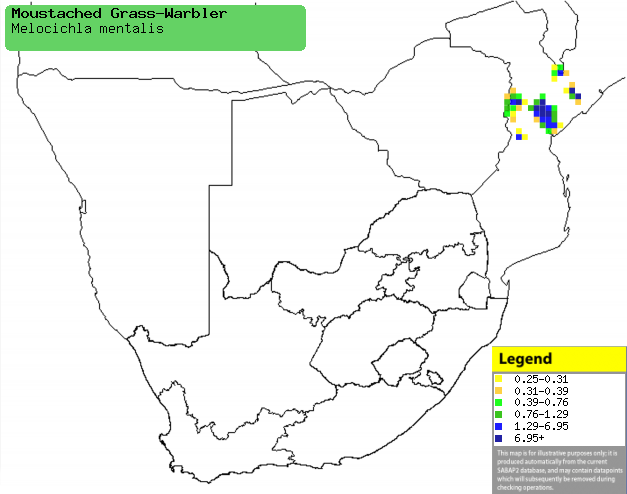|
Melocichla mentalis (Moustached
grass-warbler, Moustached warbler)
Breëstertgrasvoël [Afrikaans]; baardgrasvogel [Dutch];
Mélocichle à moustaches [French]; Bartgrassänger [German];
Felosa-de-bigodes [Portuguese]
Life
> Eukaryotes >
Opisthokonta
> Metazoa (animals) >
Bilateria >
Deuterostomia > Chordata >
Craniata > Vertebrata (vertebrates) > Gnathostomata (jawed
vertebrates) > Teleostomi (teleost fish) > Osteichthyes (bony fish) > Class:
Sarcopterygii (lobe-finned
fish) > Stegocephalia (terrestrial
vertebrates) > Tetrapoda
(four-legged vertebrates) > Reptiliomorpha > Amniota >
Reptilia (reptiles) >
Romeriida > Diapsida > Archosauromorpha > Archosauria >
Dinosauria
(dinosaurs) > Saurischia > Theropoda (bipedal predatory dinosaurs) >
Coelurosauria > Maniraptora > Aves
(birds) > Order: Passeriformes
> Family: Sylviidae
Distribution and habitat
Occurs in a band from West to East Africa, extending
southwards through eastern DRC, Angola, Tanzania to southern Africa. In this
region it only occupies small areas of Zimbabwe’s eastern highlands and adjacent
Mozambique, preferring marshy ground around streams overgrown with grass,
bracken and scattered shrubs, also in scrub between grassland and woodland or
forest.
|
 |
|
Distribution of Moustached grass-warbler in southern Africa,
based on statistical smoothing of the records from first SA Bird Atlas
Project (©
Animal Demography unit, University of
Cape Town; smoothing by Birgit Erni and Francesca Little). Colours range
from dark blue (most common) through to yellow (least common). |
Food
Its feeding habits are little known, but it has been
observed foraging on the ground, catching beetles mantids and grasshoppers.
Breeding
- Only 3 nests have been found in southern Africa, and interestingly they
vary in their descriptions. They all were bowl-shaped, but one was made of
dead banana sheathing, the other was built of strips of millet bound with
spider web, and the other was made of grass, twigs and leaves. They were
lined with soft material and placed in the center of grass tussocks.
- It lays 2-3 eggs, which are incubated mainly by the female.
- No information is available about the chicks, other than that they are
fed by both parents.
Threats
Not threatened.
References
-
Hockey PAR, Dean WRJ and Ryan PG 2005. Roberts
- Birds of southern Africa, VIIth ed. The Trustees of the John Voelcker
Bird Book Fund, Cape Town.
-
Harrison, J.A., Allan, D.G., Underhill, L.G., Herremans, M.,
Tree. A.J., Parker, V. & Brown, C.J. (eds). 1997. The atlas of southern
African birds. Vol. 2: Passerines. BirdLife South Africa, Johannesburg.
|
